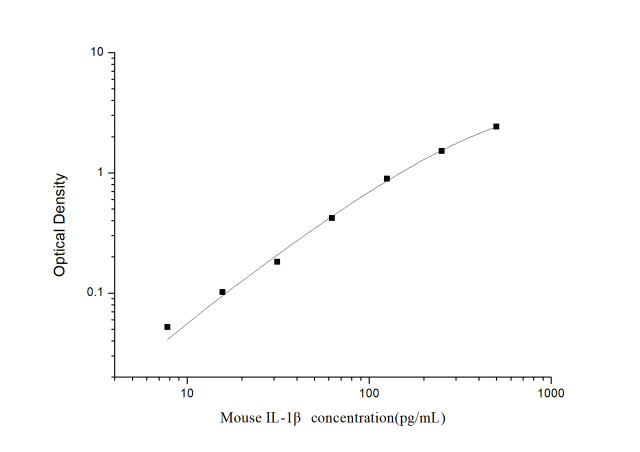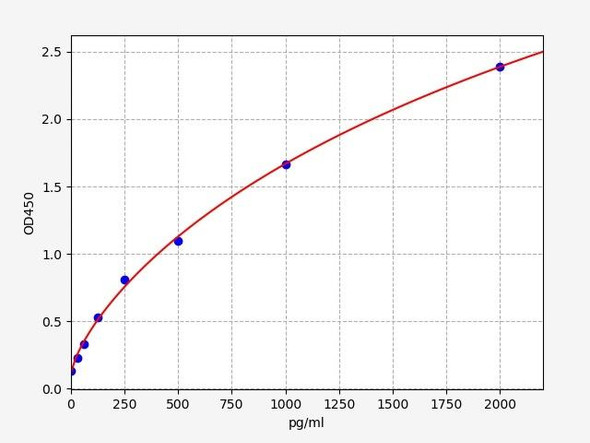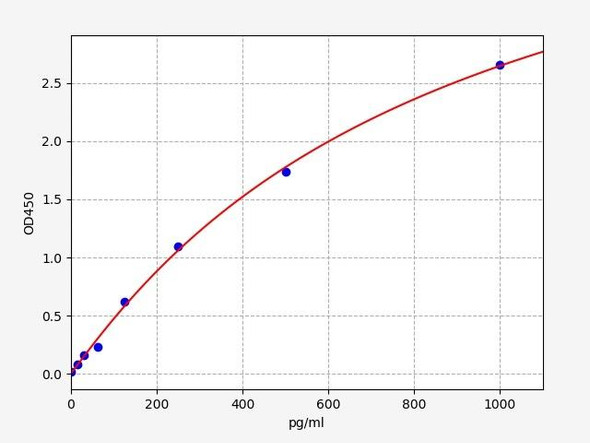Mouse TNF alpha ELISA Kit
- SKU:
- MOFI00104
- Product Type:
- ELISA Kit
- Size:
- 96 Assays
- Uniprot:
- P06804
- Sensitivity:
- 18.75pg/ml
- Range:
- 31.25-2000pg/ml
- ELISA Type:
- Sandwich
- Synonyms:
- TNFalpha, Tumor Necrosis Factor Alpha, TNF-alpha, DIF, TNF-alpha, TNFA, TNFSF2
- Reactivity:
- Mouse
Description
Mouse TNF alpha ELISA Kit
TNF-alpha (TNF-α) is a pro-inflammatory cytokine involved in immune responses and inflammation. It plays a crucial role in various physiological and pathological processes. The Assay Genie Mouse TNF Alpha ELISA Kit serves as a valuable research tool to quantitatively measure TNF-α levels in mouse samples. This kit enables researchers to investigate the role of TNF-α in disease pathogenesis, drug development, and monitoring immune system activity in mouse models, contributing to a deeper understanding of its biological functions and potential therapeutic interventions.
Key Features
| Save Time | Pre-coated 96 well plate | |
| Quick Start | Kit includes all necessary reagents | |
| Publication Ready | Reproducible and reliable results |
Overview
| Product Name: | Mouse TNF alpha ELISA Kit |
| Product Code: | Mouse TNF alpha ELISA Kit |
| Size: | 96 Assays |
| Alias: | TNFalpha, Tumor Necrosis Factor Alpha, TNF-alpha, DIF, TNF-alpha, TNFA, TNFSF2 |
| Detection Method: | Sandwich ELISA |
| Application: | This immunoassay kit allows for the in vitro quantitative determination of Mouse TNF-alpha concentrations in serum plasma and other biological fluids. |
| Sensitivity: | 18.75pg/ml |
| Range: | 31.25-2000pg/ml |
| Storage: | 4°C for 6 months |
| Note: | For Research Use Only |
Additional Information
| Recovery | Matrices listed below were spiked with certain level of Mouse TNF-alpha and the recovery rates were calculated by comparing the measured value to the expected amount of Mouse TNF-alpha in samples.
| ||||||||||||||||||||
| Linearity: | The linearity of the kit was assayed by testing samples spiked with appropriate concentration of Mouse TNF-alpha and their serial dilutions. The results were demonstrated by the percentage of calculated concentration to the expected.
| ||||||||||||||||||||
| CV(%) | Intra Assay <8 Inter Assay <10 |
Kit Components
| Component | Quantity | Storage |
| ELISA Microplate (Dismountable) | 8x12 strips | 4°C for 6 months |
| Lyophilized Standard | 2 | 4°C/ -20°C |
| Sample/Standard Dlution Buffer | 20ml | 4°C |
| Biotin-labeled Antibody (Concentrated) | 120ul | 4°C (Protection from light) |
| Antibody Dilution Buffer | 10ml | 4°C |
| HRP-Streptavidin Conjugate (SABC) | 120ul | 4°C (Protect from light) |
| SABC Dilution Buffer | 10ml | 4°C |
| TMB Substrate | 10ml | 4°C (Protection from light) |
| Stop Solution | 10ml | 4°C |
| Wash Buffer (25X) | 30ml | 4°C |
| Plate Sealer | 5 | - |
Other materials required:
- Microplate reader with 450 nm wavelength filter
- Multichannel Pipette, Pipette, microcentrifuge tubes and disposable pipette tips
- Incubator
- Deionized or distilled water
- Absorbent paper
- Buffer resevoir
Protocol
*Note: Protocols are specific to each batch/lot. For the exact instructions please follow the protocol included in your kit.
Before adding to wells, equilibrate the SABC working solution and TMB substrate for at least 30 min at 37°C. When diluting samples and reagents, they must be mixed completely and evenly. It is recommended to plot a standard curve for each test.
| Step | Procedure |
| 1. | Set standard, test sample and control (zero) wells on the pre-coated plate respectively, and then, record their positions. It is recommended to measure each standard and sample in duplicate. Wash plate 2 times before adding standard, sample and control (zero) wells! |
| 2. | Aliquot 0.1ml standard solutions into the standard wells. |
| 3. | Add 0.1 ml of Sample / Standard dilution buffer into the control (zero) well. |
| 4. | Add 0.1 ml of properly diluted sample ( Human serum, plasma, tissue homogenates and other biological fluids.) into test sample wells. |
| 5. | Seal the plate with a cover and incubate at 37 °C for 90 min. |
| 6. | Remove the cover and discard the plate content, clap the plate on the absorbent filter papers or other absorbent material. Do NOT let the wells completely dry at any time. Wash plate X2. |
| 7. | Add 0.1 ml of Biotin- detection antibody working solution into the above wells (standard, test sample & zero wells). Add the solution at the bottom of each well without touching the side wall. |
| 8. | Seal the plate with a cover and incubate at 37°C for 60 min. |
| 9. | Remove the cover, and wash plate 3 times with Wash buffer. Let wash buffer rest in wells for 1 min between each wash. |
| 10. | Add 0.1 ml of SABC working solution into each well, cover the plate and incubate at 37°C for 30 min. |
| 11. | Remove the cover and wash plate 5 times with Wash buffer, and each time let the wash buffer stay in the wells for 1-2 min. |
| 12. | Add 90 µl of TMB substrate into each well, cover the plate and incubate at 37°C in dark within 10-20 min. (Note: This incubation time is for reference use only, the optimal time should be determined by end user.) And the shades of blue can be seen in the first 3-4 wells (with most concentrated standard solutions), the other wells show no obvious color. |
| 13. | Add 50 µl of Stop solution into each well and mix thoroughly. The color changes into yellow immediately. |
| 14. | Read the O.D. absorbance at 450 nm in a microplate reader immediately after adding the stop solution. |
Sample Preparation
When carrying out an ELISA assay it is important to prepare your samples in order to achieve the best possible results. Below we have a list of procedures for the preparation of samples for different sample types.
| Sample Type | Protocol |
| Serum | If using serum separator tubes, allow samples to clot for 30 minutes at room temperature. Centrifuge for 10 minutes at 1,000x g. Collect the serum fraction and assay promptly or aliquot and store the samples at -80°C. Avoid multiple freeze-thaw cycles. If serum separator tubes are not being used, allow samples to clot overnight at 2-8°C. Centrifuge for 10 minutes at 1,000x g. Remove serum and assay promptly or aliquot and store the samples at -80°C. Avoid multiple freeze-thaw cycles. |
| Plasma | Collect plasma using EDTA or heparin as an anticoagulant. Centrifuge samples at 4°C for 15 mins at 1000 × g within 30 mins of collection. Collect the plasma fraction and assay promptly or aliquot and store the samples at -80°C. Avoid multiple freeze-thaw cycles. Note: Over haemolysed samples are not suitable for use with this kit. |
| Urine & Cerebrospinal Fluid | Collect the urine (mid-stream) in a sterile container, centrifuge for 20 mins at 2000-3000 rpm. Remove supernatant and assay immediately. If any precipitation is detected, repeat the centrifugation step. A similar protocol can be used for cerebrospinal fluid. |
| Cell culture supernatant | Collect the cell culture media by pipette, followed by centrifugation at 4°C for 20 mins at 1500 rpm. Collect the clear supernatant and assay immediately. |
| Cell lysates | Solubilize cells in lysis buffer and allow to sit on ice for 30 minutes. Centrifuge tubes at 14,000 x g for 5 minutes to remove insoluble material. Aliquot the supernatant into a new tube and discard the remaining whole cell extract. Quantify total protein concentration using a total protein assay. Assay immediately or aliquot and store at ≤ -20 °C. |
| Tissue homogenates | The preparation of tissue homogenates will vary depending upon tissue type. Rinse tissue with 1X PBS to remove excess blood & homogenize in 20ml of 1X PBS (including protease inhibitors) and store overnight at ≤ -20°C. Two freeze-thaw cycles are required to break the cell membranes. To further disrupt the cell membranes you can sonicate the samples. Centrifuge homogenates for 5 mins at 5000xg. Remove the supernatant and assay immediately or aliquot and store at -20°C or -80°C. |
| Tissue lysates | Rinse tissue with PBS, cut into 1-2 mm pieces, and homogenize with a tissue homogenizer in PBS. Add an equal volume of RIPA buffer containing protease inhibitors and lyse tissues at room temperature for 30 minutes with gentle agitation. Centrifuge to remove debris. Quantify total protein concentration using a total protein assay. Assay immediately or aliquot and store at ≤ -20 °C |
| Breast Milk | Collect milk samples and centrifuge at 10,000 x g for 60 min at 4°C. Aliquot the supernatant and assay. For long term use, store samples at -80°C. Minimize freeze/thaw cycles. |
TNF alpha Background
Tumor Necrosis Factor alpha (TNF Alpha)
Tumor Necrosis Factor-alpha (TNF-α) is a cytokine that plays a pivotal role in immune responses and inflammation. It is a pro-inflammatory protein involved in various physiological and pathological processes, including host defense, tissue repair, and the pathogenesis of autoimmune diseases. TNF-α is produced by multiple cell types, such as macrophages and T cells, and exerts its effects by binding to two distinct receptors, TNFR1 and TNFR2. Upon activation, TNF-α triggers signaling pathways that regulate gene expression, immune cell recruitment, and cellular responses. Due to its critical role in inflammatory conditions, TNF-α has been extensively studied, leading to the development of therapeutic agents targeting this cytokine to modulate immune responses and alleviate inflammatory diseases.
TNF alpha Gene
The TNF-alpha gene in mice, also known as Tnf, is located on chromosome 17. It encodes a pro-inflammatory cytokine protein, TNF-α, which is involved in multiple cellular processes, including immune responses, apoptosis, and inflammation. The Tnf gene consists of four exons and three introns and undergoes transcriptional regulation to produce TNF-α mRNA.
In mice, the absence of this gene is linked to impaired responses to bacterial infection, as well as deficiencies in the formation of organized follicular dendritic cell networks and germinal centers, leading to a lack of primary B cell follicles. Furthermore, alternative splicing gives rise to several transcript variants, contributing to the diversity of gene expression.
TNF alpha Protein Structure
The mouse TNF-alpha protein is a homotrimeric type II transmembrane glycoprotein. It is composed of 235 amino acids and has a molecular weight of approximately 17.3 kDa. The extracellular region of TNF-α contains a cytokine domain that forms a trimer, while the intracellular domain anchors the protein to the cell membrane. Upon cleavage by proteases, the soluble form of TNF-α is released from the membrane.
Predicted Structure of Mouse \TNF alpha. Source: Uniprot
Function of TNF alpha
TNF-α plays a crucial role in regulating immune responses and inflammation. It acts as a potent pro-inflammatory cytokine, initiating and amplifying the immune response in various physiological and pathological conditions. TNF-α is produced by several cell types, including macrophages, T cells, and natural killer cells. It can induce the expression of other cytokines, chemokines, and adhesion molecules, promoting leukocyte recruitment, tissue repair, and host defense mechanisms.
TNF alpha mechanism of action
TNF alpha Receptor and TNF alpha signalling pathways
TNF-alpha (TNF-α) exerts its biological effects by binding to two distinct cell surface receptors: TNF receptor 1 (TNFR1) and TNF receptor 2 (TNFR2). These receptors belong to the TNF receptor superfamily, which is characterized by the presence of cysteine-rich repeats in their extracellular domains. While both TNFR1 and TNFR2 can bind TNF-α, they differ in their downstream signaling and biological functions.The balance between TNFR1 and TNFR2 signaling is critical in determining the overall cellular response to TNF-α.
1. TNF Receptor 1 (TNFR1): Also known as p55 or CD120a, TNFR1 is widely expressed on various cell types, including immune cells, endothelial cells, and many other cell types. TNFR1 signaling can activate multiple pathways, including the canonical NF-κB pathway, which leads to the transcriptional activation of genes involved in inflammation, cell survival, and immune responses. TNFR1 activation can also initiate apoptotic pathways, promoting cell death under certain conditions.
2. TNF Receptor 2 (TNFR2): Also known as p75 or CD120b, TNFR2 is expressed on a more restricted set of cells, such as immune cells, endothelial cells, and some neuronal cells. TNFR2 signaling can activate similar pathways to TNFR1, including the NF-κB pathway. Additionally, TNFR2 can promote cell proliferation, survival, and immune cell activation. It plays a crucial role in regulating immune responses and tissue homeostasis.
TNF alpha Clinical Significance
The dysregulation of TNF-α has been implicated in various human diseases, including autoimmune disorders, chronic inflammation, and cancer. Elevated levels of TNF-α have been observed in conditions such as rheumatoid arthritis, Crohn's disease, and psoriasis. Conversely, decreased TNF-α production or impaired signaling can lead to immunodeficiency and increased susceptibility to infections. Due to its clinical significance, TNF-α has become an important therapeutic target for the development of drugs and therapies.
TNF alpha agonists and Tnf alpha antagonists
Given the crucial role of TNF-α in inflammation and immune regulation, researchers have developed both agonists and antagonists/blockers to modulate its activity. TNF-α agonists, such as etanercept and adalimumab, are engineered proteins that mimic the natural ligand, enhancing TNF-α signaling. These agonists have been employed in the treatment of certain autoimmune diseases. Conversely, TNF-α antagonists/blockers, including infliximab and certolizumab, bind to TNF-α and prevent its interaction with receptors, thereby reducing the inflammatory response. These antagonists have shown efficacy in treating various inflammatory conditions, such as rheumatoid arthritis and inflammatory bowel disease.
TNF alpha Fact Sheet
| Gene Name | Tnf |
| Gene ID | 21926 |
| Uniprot ID | |
| Full Name | Tumor necrosis factor |
| Protein Family | |
| Molecular Weight | 17.3 kDa |
Citations
| Ioannou et al. | Treatment of the CRND8 mouse model for cerebral amyloid angiopathy, exhibited increased levels of neuron specific enolase in brain tissue following long-term treatment with a modified C5a receptor agonist, accompanied by improved cognitive function. | Biochemical and Biophysical Research Communications 2023 | PubMed ID: 37454400 |
Related Products
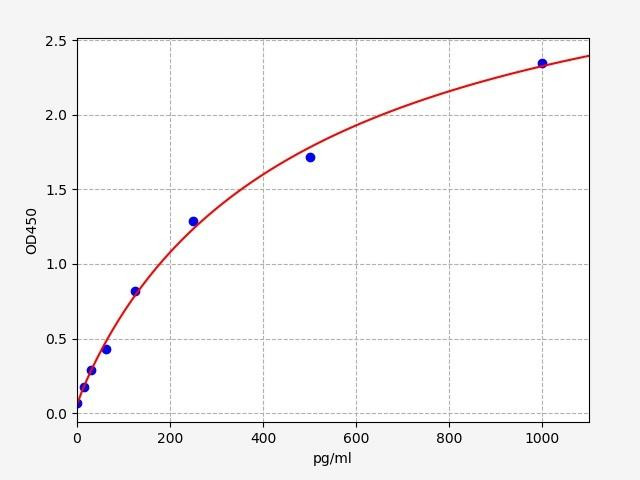
| Mouse IL-6 ELISA Kit | |
|---|---|
| ELISA TYPE: | Sandwich ELISA, Double Antibody |
| SENSITIVITY: | 9.375pg/ml |
| RANGE: | 15.625-1000pg/ml |
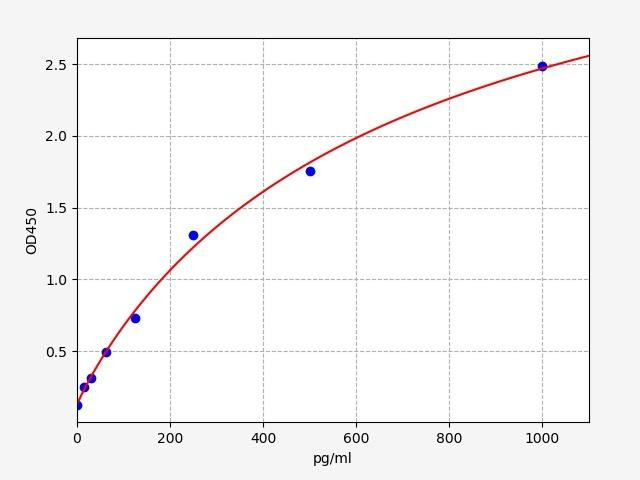
| Mouse IL-10 ELISA Kit | |
|---|---|
| ELISA TYPE: | Sandwich ELISA, Double Antibody |
| SENSITIVITY: | 9.375pg/ml |
| RANGE: | 15.625-1000pg/ml |


